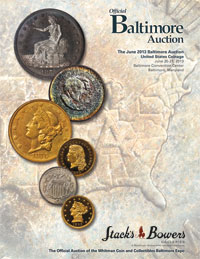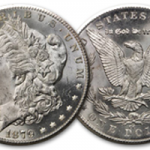 Baltimore! The very name evokes numismatic excitement! No other city in America has a greater or finer tradition.A few comments about the glories of Baltimore’s numismatic past.
Baltimore! The very name evokes numismatic excitement! No other city in America has a greater or finer tradition.A few comments about the glories of Baltimore’s numismatic past.
Back in the early 19th century, during the 1830s and 1840s, Baltimorean Robert Gilmor, Jr. built one of the finest cabinets ever, which included gold Proofs supplied to him by the Mint, a Brasher doubloon, and more. Unfortunately for posterity, the collection was dispersed privately, and no catalogs of it exist. (Our friend and scholar, Dr. Joel Orosz, has chronicled much of Gilmor’s life.)
Shortly after, Mendes I. Cohen, member of a leading banking family, assembled a marvelous collection that included gold Proof sets, and was auctioned in 1875. In the meantime, T. Harrison Garrett, scion of the family that controlled the Baltimore & Ohio Railroad, was busy assembling the very finest private collection of the century, studying coins in his Evergreen House mansion on North Charles Street with his collection of autographs (signers of the Declaration), elephant-folio Audubon prints, and world-class library nearby. This collection was continued by his sons and in 1942 given to The Johns Hopkins University.
In a series of memorable catalogs, we showcased the collection for the University in four sales from 1979–1981. Appraised at about $9 million, it realized $25 million. Numismatic history was made!
Into the 20th century, Waldo C. Newcomer, president of a Baltimore bank, formed a marvelous collection of American and world coins — one of the finest ever. It was sold privately through some miscellaneous Morgenthau auctions in the 1930s, leaving few traces. It is too bad that we, starting business in 1933, did not have the opportunity to showcase it in a “name” catalog. Today, records of what Newcomer had are incomplete.
 The collection of all collections was also formed in Baltimore around 1925, when Louis E. Eliasberg, a student of economics, quickly realized the importance of gold and began collecting coins. In 1942, already with a fine holding, he bought The John H. Clapp Collection from us through private treaty for $100,000, tying the record for a private transaction and bringing far more than the total of the W.F. Dunham Collection auctioned by B. Max Mehl in 1941 — the highlight of that distinguished dealer’s career.
The collection of all collections was also formed in Baltimore around 1925, when Louis E. Eliasberg, a student of economics, quickly realized the importance of gold and began collecting coins. In 1942, already with a fine holding, he bought The John H. Clapp Collection from us through private treaty for $100,000, tying the record for a private transaction and bringing far more than the total of the W.F. Dunham Collection auctioned by B. Max Mehl in 1941 — the highlight of that distinguished dealer’s career.
One success led to another and by 1950, through careful study and aggressive bidding and buying, Mr. Eliasberg achieved what no one had ever done before, or will ever to again: his collection was complete with every date and mintmark of United States coins from the 1792 half cent to the 1933 double eagle!
We were honored by his family who consigned the collection to us. Sold in a series of auctions beginning in 1982, The Louis E. Eliasberg, Sr. Collection catalogs today stand as a cornerstone in any important numismatic library.
To bring the Baltimore tradition up to date, we note that a survey of dealers and others have named the city as the very favorite place to hold a convention! With its fine accommodations, easy access by air, rail and road, and as the center of American numismatic activity, it is the place to be — including for our June sale!
Six Collections in 2013
While this sale is long over, we wanted to continue to share the highlights with the numismatic world. This is what we said in 2013:
Our Baltimore sale is anchored by not one, not two or three, but by six notable collections, each with different specialties. The Legendary L. Craige Collection of Colonial & Early American Coins Part IV continues our presentation of a cabinet formed by a fine gentleman who was the very definition of a connoisseur. The Raymond W. Dillard Collection of Elongated Coins Part IV will create a lot of attention, including two quarter eagles. In case you haven’t noticed, exonumia—medals, tokens and other things outside of the federal series—are hot tickets in the marketplace. Where else in American numismatics can a modest budget build a memorable collection?
The Linnemann Family Collection offers a wide selection of United States coins long off the market. High quality is the order of the day! Additional coins from The Edward J. Monaghan Collection will attract interest as well. The William Porter Collection of Carson City Mint Coinage, Part II, was formed by the founder of eTrade. Of all mints in the history of our country, Carson City is the most popular. That is, the CC mintmarked coins from this mint, which operated only from 1870–1885 and again from 1889–1893, are everlastingly in demand.
And, that is not all! As you turn the pages in our catalog or advance in our listing on your computer screen, you will find many other coins of interest and importance, including a beautiful 1776 Continental dollar, a remarkable mint error 1859 Indian cent, a Gem 1925-S Buffalo nickel, a historical 1792 half disme, a rare Wass, Molitor & Co. $10 from the S.S. Central America, Gem Mint State and Proof copper, nickel, silver, and gold, and more. And, as might be expected, you’ll find a panorama of beautiful coins in such popular series as Morgan dollars, commemoratives, and coins of the 20th century.
